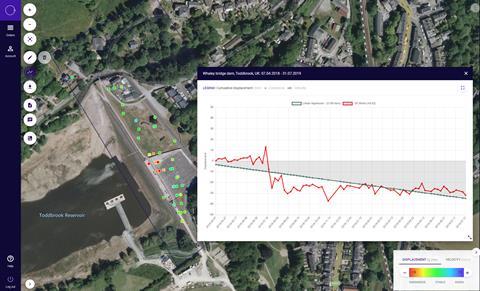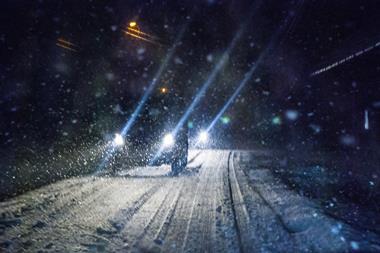The former Lloyd’s Lab participant believes dam failure can be classified as a black swan event
When it comes to dams, there are two intertwined challenges affecting this industry - the fact that dam infrastructures are deteriorating due to their age, while the rapid pace of climate change is further pushing these buildings to breaking point.
A concrete dam, which is used to stop or restrict the flow of surface water or underground streams, usually shows signs of ageing at 50-years-old - however, in the UK, most dams have already surpassed the 100-year mark. This is largely due to a post-Second World War dam building frenzy in the mid-20th century, where more than 1,100 dams were constructed each year between the late 1950s and 1970s.

For example, in 2020, the average age of a large dam in the UK was 106-years-old, according to market and consumer data firm Statista.
Speaking exclusively to Insurance Times, Reijo Pold, founder and chief strategy officer at insurtech ValueSpace, said: “The world now needs a cost effective way to de-risk. Most of [the UK’s] dams were built in the 1950s and they are all ageing at the same time.”
He explained that many UK dams have passed their “alert age” which means they have exceeded the 50-year threshold.
Helping the insurance industry to address and mitigate this structural risk is where Pold’s insurtech, ValueSpace, aims to have an industry-wide impact.
The company, which participated in Lloyd’s Lab’s cohort four in April 2020 before being incorporated in May 2022, uses satellites to assess commercial properties and infrastructure, seeking to spot early indicators of potential damage or deformation.
The insurtech can also review how infrastructure assets have behaved over the past seven years.
The firm believes this information can help insurers improve their combined operating ratios by reducing possible claims losses and repair expenses.
Pold noted that, to date, ValueSpace has produced 3,500 risk profiles across more than 70 countries, saving £19m for its current clients and more than 152 tonnes of carbon emissions.
“The hypothesis was that in terms of alert age, if dams hit the alert age, then more losses will be happening, Pold said.
“Getting all these dams monitored is pretty expensive and not economically feasible. We can do this as at fraction of the cost from space.”
However, the materials dams are made from are also key – Pold explained that each material has “different thresholds and bearings”.
“Certain materials can withstand more deformation than others,” he added.
Climate change impact
ValueSpace’s proposition is even more pertinent considering that there is ”no immediate answer” to climate change, which continues to erode and impact global infrastructure, added former Lloyd’s Lab head of innovation Ed Gaze, who joined the insurtech as an investor and advisor in August 2022.
Read: ValueSpace joins UK government’s UK-US insurtech corridor
Explore more news content here
Gaze continued: “We are on the road to reducing [carbon] emissions, but it’s not an easy one to write policy for.
”From our point of view there’s going to be more [global] warming baked in and more uncertainty. It’s also about the extreme weather patterns that happen as a result.”
Climate change driven weather patterns, such as long, dry periods followed by wet periods, could cause situations like landslides. In turn, events such as these ”can cause the decline of big infrastructure – especially with the age being beyond alert age,” he added.
Gaze emphasised that if the industry stops insuring oil and gas projects, this could subsequently create a potentially worse situation.
He explained: ”If there’s no insurance, then ultimately, somebody’s going to suffer because insurance isn’t paying up when inevitable bad things happen.
”Insurance plays a great role when bad things happen – it’s too simplistic to say ’do not insure [fossil fuel projects]’.
“[Renewable energy sources are] not a quick win and we need fossil fuels to balance out the times when the sun is not shining or the wind is not blowing.”
Read: Ex-Lloyd’s Lab head Ed Gaze scoops new role at alumnus insurtech
Explore more news content here
Potential black swan event
Like the Covid-19 pandemic, Gaze and Pold noted that mass dam failure could be classified as a black swan event because it can be classed as a negative event that is difficult to predict.
Pold said: “It’s interesting to see now that these predictions are actually coming to fruition. As dams get older, they collapse quicker. Environmental damage could be huge. Social damage as well. Loss of life is also a factor.”
Despite this outlook, Pold is hopeful. He stressed that “everyone wins if we work together”.
This includes getting government involvement.
“We are very much on the same page now, but things need to start moving quicker and de-risking dams. It’s a huge task at hand, but if we can help prevent some of these dam failures happening in the world, then it is something we want to work towards on a global scale. The impact will be big,” Pold added.
PASS NOTES
What is the financial and human impact of unstable dams?

One of the oldest dams in the UK is Whaley Bridge. Built in 1831 in Derbyshire, more than 1,500 residents have been forced to evacuate their homes after the dam partially collapsed in August 2019 following torrential rain.
Work to repair Toddbrook Reservoir in Whaley Bridge, costing £15m, only began in March this year.
Meanwhile, in March 2021, US-based dam Piney Point suffered a leak in its liner, causing a partial breach in the reservoir’s containment walls. This led to 200 million gallons of polluted water being pumped into Port Manatee and Tampa Bay.
It cost the state of Maryland $85m (£75m) to clean up the incident – it now plans on closing the dam by December 2024.
What else has ValueSpace been up to?
In October 2022, the insurtech joined the first cohort of the Department for International Trade’s UK-US insurtech corridor.
The corridor, which launched in March 2022, aims to provide a formal pathway for UK businesses to expand into the US, reducing barriers to expansion for these businesses.
The corridor provides access to the insurance regulator in Connecticut as well as office space and a network of stakeholders to support businesses with insurance, investment, professional services and recruitment needs.
Pold said: ”In the US, there’s a big problem ahead from an infrastructure perspective and we want to do more in the region.”
Hosted by comedian and actor Tom Allen, 34 Gold, 23 Silver and 22 Bronze awards were handed out across an amazing 34 categories recognising brilliance and innovation right across the breadth of UK general insurance.




















































No comments yet